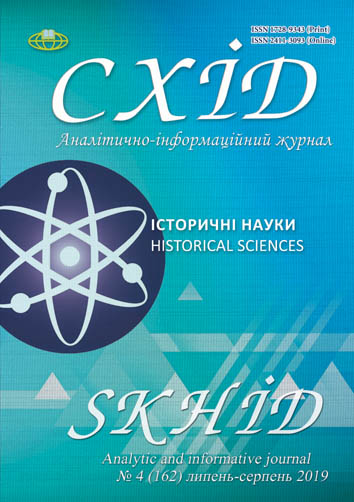Agrarian legislation of interwar Poland: specificities of its implementation in Eastern Galicia
DOI:
https://doi.org/10.21847/1728-9343.2019.4(162).176986Keywords:
Eastern Galicia, agrarian legislation, Poland, interwar period, reforms, comasation, parcelation, settlementAbstract
Reforming the legal framework of the agrarian legislation of the Second Polish Republic lied in the need to improve socio-economic changes in the system of agrarian land-use. An important basis for this process was supposed to be the creation of a proper legal framework, which, by ensuring the inviolability of private land ownership, created opportunities for the formation and strengthening of farms and would contribute to the elimination of landlessness and land hunger. The implementation of the laws of 1919 and 1920 in the agricultural sector was extremely slow, which forced to seek new ways and approaches to its reforming. In view of the difficult political situation in the eastern and southeastern provinces, taking into account the demands of political forces for reforming land relations in the interest of the peasants, the Sejm adopted a new law on the “Implementation of Agrarian Reform”, which came into force in December 1925. This legislative act determined the basic parameters of agrarian sector reforming up to 1939. Although Poland’s agrarian legislation largely protected the interests of large landowners, it at the same time contributed to the creation of new farms, improved the mechanism of legal registration of land rights, which strengthened civilized market relations in the economic sector. Separate legislative acts (1923, 1928, 1932 years) normalized the elimination of strip cropping and strip farming (comasation), which slowed the development of intensive agriculture; regulated leasing relations in the agricultural sector, which contributed to its transition to market conditions of functioning; allowed land reclamation works with the aim of optimizing the use of soil potential. State agrarian legislation and government policy had exacerbated national and social contradictions in society. Warsaw’s intention to change the quantitative relation of the Ukrainian and Polish populations in favor of the latter through the resettlement of colonists from the Polish ethnic territory to western Ukrainian lands, which were supposed to create strong households and become an important social and political support of the authorities, had failed.Downloads
References
Pavlykovskyi, Yu. (1922). Zemelna sprava u Skhidnii Halychyni (korotkyi istorychnyi i ekonomichnyi ohliad zemelnoho pytannia ta suchasnyi yoho stan). Lviv. 45 p. (In Ukrainian).
Fialkowski, H. (1937). Uporzadkowanie stanu prawnego drobnych gospodarstw na ziemiach wschodnich. Lublin, 16 p. (In Polish).
Ohanowicz, A. (1926). Ustawa o wykonaniu reform rolney i inne ustawy rolne. Poznan. 504 p. (In Polish).
Rocznik ziem Wschodnich. (1939). Warszawa: Wydawnictwo Zarządu Głównego Towarzystwa Rozwoju Ziem Wschodnich, 96 p. (In Polish).
Wojciechowski, S. (1965). Moje wspomnienia. Рaryz: Instytut literacki, 527 p. (In Polish)
Rosloniec, S. (1927). Rozdrobnienie gospodarstw w Polsce. Rolnik ekonomista. Warszawa, 3, 443-456. (In Polish).
Vasiuta, I. (2010). Halytsko-volynske selo mizh svitovymy viinamy. Lviv: Kameniar, 507 p. (In Ukrainian).
Vyzdryk, V. (2013). Polske ahrarne osadnytstvo na zakhidnoukrainskykh zemliakh u 20-kh rr. XX st. Hrani, 6, 4-7. (In Ukrainian).
Vytanovych, I. (1936). Ukrainske selianstvo na shliakhu do pobidy. Istoriia ukrainskoho selianstva. Lviv: Samoosvita, 40 p. (In Ukrainian).
Zuliak, I. (2002). Osoblyvosti polskoi polityky na zakhidnoukrainskykh zemliakh (1919-1939). Naukovi zapysky Ternopilskoho derzhavnoho pedahohichnoho universytetu im. V. Hnatiuka. Seriia: Istoriia. Ternopil. Issue 3. pp. 39-47. (In Ukrainian).
Yova, P. (1954). Borotba trudiashchykh Zakhidnoi Ukrainy za vozz’iednannia z Radianskoiu Ukrainoiu. Lviv. 113 p. (In Ukrainian).
Smolei, V. (2003). Polske tsyvilne i viiskove silskohospodarske osadnytstvo v Zakhidnii Ukraini (1919-1939 rr.). Ternopil: Pidruchnyky i posibnyky, 112 p. (In Ukrainian).
Borkowski, J. (1981). Chłopi Polacy w dobie kapitalizmu. Warszawa, 234 p. (In Polish).
Brzoza, Cz. (2001). Polska w czasach niepodległości i ІІ wojny światowej (1918-1945). Krakow, 424 p. (In Polish).
Torzecki, R. (1989). Kwestia ukraińska w Polsce w latach 1923-1929. Kraków: Wydawnictwo Literackie, 467 p. (In Polish).
Włudyka, T. (1994). “Trzecia droga” w myśli gospodarczej II Rzeczypospolitej. Krakόw, 169 p. (In Polish).
Downloads
Published
How to Cite
Issue
Section
License
Copyright (c) 2019 Vitaliy Vyzdryk, Oleksandra Melnyk, Oleg Muravskiy

This work is licensed under a Creative Commons Attribution-NonCommercial-NoDerivatives 4.0 International License.
1. Authors bear responsibility for the accuracy of facts, quotations, numbers and names used.
2. Manuscripts are not sent back.
3. The publisher does not always agree with the authors' opinion.
4. The authors reserve the right to authorship of the work and pass the first publication right of this work to the journal under the terms of a Creative Commons Attribution-NonCommercial-NoDerivatives 4.0 International License. This license allows others to distribute (copy) the published work for non-commercial purposes, provided there is mandatory attribution to its authors and a link to the first publication in our journal.
5. The authors have the right to conclude separate supplement agreements that relate to non-exclusive work distribution in the form in which it has been published by the journal (for example, to upload the work to the online storage of the journal or publish it as part of a monograph), provided that the reference to the first publication of the work in this journal is included.

